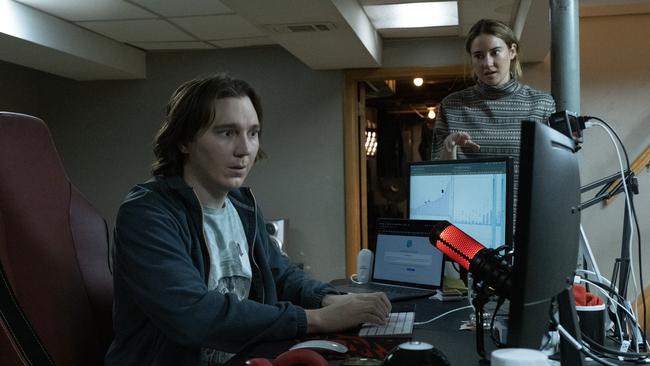Dumb Money: ASX is going nowhere fast
The message from the sharemarkets in 2023 is that you cannot ‘set and forget’ – it’s just not that easy.

This weekend the movie Dumb Money goes on general release: it’s about how a ragged bunch of day traders during the Covid period had a momentary win against Wall Street – before the stock that made some a quick fortune eventually left the majority of the group high and dry.
We’ve had important investment movies before: The Big Short and The Social Network.
But the release of this film, which specifically concerns the day trader ‘Roaring Kitty’ and his moves around videogame store company GameStop has a local twist.
The Australian Securities and Investments Commission has made a special advert, which will run before Dumb Money screenings. The ASIC advert is simple and effective – if something looks too good to be true, it probably is.
Perhaps ASIC could make a whole series of cinema adverts on the risks to be found in off-the-plan property or speculative mining stocks.
It might even make one that addresses the reality of so-called passive investing.
The message might be – investing is never that easy and your Exchange Traded Fund based on the local sharemarket may go nowhere for years.
Because this year’s sharemarket is looking like a wake-up call for all those who thought they could just ‘set and forget’ after buying index funds.
Sorry folks, if it was that easy, one algorithm could be an investor for us all.
The reality is starkly different: the ASX 200 for the year to date is now showing a drop of around 2 per cent. Close off the books now and we have lost money on the ASX this year.
We are also in correction territory with both the major US markets and our own ASX 200 potentially dropping more than 10 per cent from recent peaks.
No wonder investors who were happy with shares and cash for a generation are being lured into uncharted waters of bonds and private equity.
And just in case you remain sceptical that the wider sharemarket is better than it sounds here, keep this in mind – in 2007, the ASX 200 was at a commodity-driven peak of 6853, today it is at 6833.
Welcome to the Australian sharemarket: going nowhere fast.

Hold on, you say, if shares are that bad then how come the super returns have been reasonable for many years. How come we see reports of investors making fortunes on the market every other day?
A better way to look at it all might be total returns, which are what really matter to the everyday investor.
Yes, the sharemarket has been hopeless in terms of price gains over both the short term and long term (that is, back to that cyclical peak of late 2007), but investors also receive returns from dividends.
In fact, we have one of the highest-paying dividend markets in the world with an average dividend yield of about 4.3 per cent, which is twice as high, for example, as Wall Street.
On the Money Puzzle podcast this week, stockbroking analyst and author Danielle Ecuyer makes the point that if you were to look at total returns, reinvesting all dividends, and compounding the numbers, the ASX has returned something closer to 80 per cent since 2007.
Every year – whatever happens your sharemarket ETF or your bag of blue-chip banks and miners are going to return at least 4.3 per cent.
So if we ruled off the books this weekend – even with the miserable performance year to date – the total return would still be positive at around 2 per cent.
What’s more, we have not allowed for franking, which can typically lift the returns you get in your pocket to above 6 per cent – especially for older Australians in tax-free retirement.
But 2023 is looking like a year where we are seeing in black and white the price we pay for the dividend largesse of Corporate Australia.
We are still running on dividend payout ratios close to more than 60 per cent; there have been times when major banks let the dividend payout ratios run above 90 per cent.
Flip that over and it means that major Australian companies will typically have a third or less of their profits leftover to invest in the business.
In recent times, the miners have effectively joined forces with the banks in becoming dividend machines – the BHP and Rio dividend payout are among the biggest in the world in absolute dollar terms.
And even though the big miners withdrew from a formal commitment to regular dividends, the reality is that when the cycle goes their way they offer enormous dividends payouts.
Money that might be invested goes instead to dividend payments, which in turn must mean less spending on new projects.
As Wealth contributor Roger Montgomery has pointed out more than once, the successful Australian investor is unlikely to have invested in the market. Rather, the investor is committed to the best-qualified stocks that can pay the average dividend and grow earnings, which will translate to share price growth.
As an independent investor, it‘s up to you whether the sharemarket and its reliable 4.3 per cent dividend yield is enough for you.
It has to be set against inflation and inflation is still running higher than 5 per cent – so in real terms, you lose.
It certainly suggests that the notion that you can have an entire share portfolio held in index-based ETFs is flawed.
This is not, for one moment, an argument in favour of active fund managers who promise they will ‘beat the maker’.
The bulk of active fund managers will not match the index over extended periods – we know from the statistics, this is irrefutable.
Rather these modest numbers in 2023 are an argument for a sharemarket approach recommended by many top advisers where ETFs can be the core of a portfolio – ensuring you do at least get ‘an average market return’.
You then have ability to supplement that core holding with the stocks that suits you best.
If you are older and seeking income, those banks and miners have their place.
If you are younger and looking to build wealth through shares, then it‘s time to take a look at the growth winners such as CSL, Carsales, NextDC, REA (a News Corp company), ResMed or WiseTech.
Just don’t set and forget, because if you do, Australian shares will let you down for very long periods of time.






To join the conversation, please log in. Don't have an account? Register
Join the conversation, you are commenting as Logout